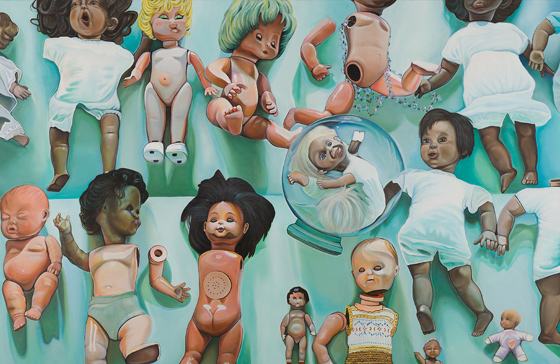[scroll down for english Version]
Vernissage Do. 7. Mai 19 bis 21 Uhr
Ausstellungsdauer: 8. Mai bis 20. Juni 2009
Es ist ein bekanntes Phänomen, dass suizidgefährdete Personen sich vorstellen, wie sie aussehen, wenn sie gefunden werden. Dies war ein Thema, das Amina Broggi in der Serie „abgewandt“ verfolgte; faszinierend schockierend zugleich, weil die fröhliche Farbigkeit den Schrecken der Gedanken übertüncht, weil sie in der glatten Ästhetik die Verlockungen vorführt, ohne in der Semantik der Bilder die Gefahren zu vernachlässigen, weil sie ein altes Thema der Wiener Sezession sehr zeitgemäß aufgreift: die Erotik des Sterbens im heutigen Medien-Zeitalter, das in der Werbung wie in der Berichterstattung ohne manipulierte Bilder nicht mehr auskommt. „abgewandt“ zeigt ausschliesslich junge Frauen als Rückenakt, als Porträt in extremer Auf- oder Untersicht, im Close up, die vor allem schön sind.
Amina Broggi befasste sich nicht nur in dieser Serie mit aussergewöhnlichen Facetten von Leben und Tod in der Gesellschaft des 21. Jahrhunderts. In ihrer „Pigeons-Serie“ erhob sie in einer zeitlosen, in sich ruhenden Atmosphäre blendender Stillleben die unschöne Realität von Tauben in der Großstadt zum Faszinosum. Ob mit Gummihandschuhen die Schwungfedern einer Taube gespreizt werden, diese verstümmelt im Rinnstein liegt oder gerade munter auf einer auf dem Boden stehenden Lederhandtasche gelandet ist, immer schwingt wie auf Tierstillleben die Metaphorik des Überflusses im negativen wie im positiven Sinne mit und wirkt als ein Lehrbild über das Leben schlechthin.
Der Anblick einer gestrandeten Ladung von Puppen im Hafen von Accra in Ghana gab den Anstoß zu ihrer neuesten Serie „Glaskinder“. Hier sind es nicht mehr Lebewesen, sondern, quasi diese stellvertretend, Puppen, die die Bilder bevölkern. Broggi spießte die Fragmente am Strand auf und fotografierte sie, um diese Aufnahmen für ihre Bildkompositionen im Atelier zu nutzen. Zurück in Berlin beschaffte sie sich auch fabrikneue Puppen und nutzte sie als Modelle für ihre Leinwände, die im Atelier entstanden. Die „Glaskinder“ stehen für die Künstlerin für die schmerzhafte Entwicklung vom Kind zum Erwachsenen, zu „Kopfmenschen“, wie Amina Broggi sagt, eine Entwicklung, die vom Betrachter als ein Durchwandern von Tatorten auf den Bildern erfahren wird.
Die 1980 in Altstätten in der Schweiz geborene und in Fürstentum Liechtenstein aufgewachsene Künstlerin Amina Broggi studierte an der Universität für angewandte Kunst in Wien. 2007 erhielt sie ihr Diplom. Sie lebt und arbeitet in Wien und Berlin. Zahlreiche Ausstellungen, darunter 2005 „Real – Junges Österreich“ Kunsthalle Krems, 2005 „emerging artists: hotspots“, Sammlung Essl, Klosterneuburg, 2007 „exitus. tod alltäglich“, Künstlerhaus Wien.
It is a familiar phenomenon that suicidal individuals tend to envision what they might look like at the moment in which they are found. This is one of the central issues, which Amina Broggi pursues in her series abgewandt (‘averted’) – a group of works that is fascinating and shocking in equal measure because its exuberant colorfulness covers up the horror of the subject matter, because enticements are presented in a sleek aesthetic without disregarding the potential dangers in the semantics of the images, and because it reenergizes an old theme of the Vienna Secession in a highly contemporary manner: the eroticism of death in today’s media age which in our time depends on manipulated images in both the fields of advertising and news coverage. The series abgewandt exclusively features close-ups of young nude women, which are primarily beautiful and are depicted from the back and from an extreme high or low angle.
Amina Broggi has not only dealt with unusual facets of life and death in the 21rst century in this particular series. In her series of Pigeons, she elevates the unpleasant reality of big city pigeon plagues to intriguing scenarios in the timeless, meditative atmosphere of radiant still lifes. Whether the wing feathers of a pigeon are being spread apart with rubber gloves, a maimed pigeon is lying in the gutter or has only just jauntily landed on a leather handbag standing on the ground: as in animal still lifes, the symbolism of abundance is always resonant in a both negative and positive sense, appearing like a paradigm of life itself.
The experience of observing a stranded shipment of dolls in the harbor of Accra in Ghana gave the artist the impulse for her latest series Glaskinder (‘Glass Children’). Here, the images are no longer inhabited by living entities but rather, as quasi substitutes, by dolls. Broggi gathered up the fragments on the beach and photographed them, using these images in the production of pictorial compositions in her studio. Back in Berlin, where the artist resides, she also acquired brand-new dolls, employing them as models for her paintings. For Amina Broggi, the ‘Glass Children’ stand for the painful development from childhood to adulthood, to the state of being a ‘mental being’, as she states – a development that in the paintings is made palpable to the viewers as a journey traversing sites of crime.
The artist Amina Broggi, who was born in 1980 in Altstätten in Switzerland and grew up in the Principality of Liechtenstein, studied at the University of Applied Arts in Vienna. She received her diploma in 2007, and works and resides in Vienna and Berlin. Amina Broggi has participated in numerous exhibitions, among others, in Real – Junges Österreich, Kunsthalle Krems (2005), emerging artists: hotspots, Sammlung Essl, Klosterneuburg (2005), exitus. tod alltäglich, Künstlerhaus Wien (2007).

